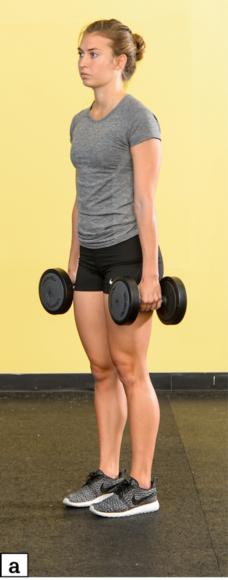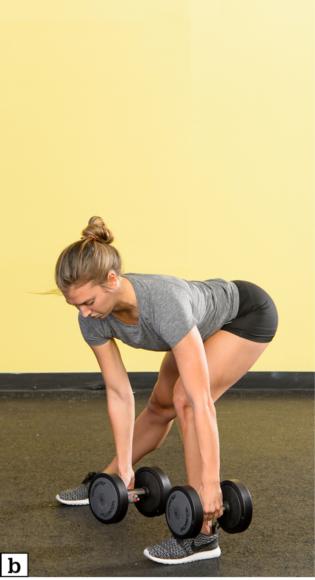Dumbbell and Kettlebells
This is an excerpt from Functional Training by Juan Carlos Santana.
Once body weight and bands or cables are mastered, dumbbells (DB) and kettlebells (KB) are the equipment of choice to externally load any functional training exercise. Because they allow you to load each hand and perform exercises on the right side and left side, they can address muscular imbalances easily and naturally. The ability to use heavy or light loads allows you to focus on any quality you desire, from heavy strength work to light endurance work and everything in between. Even asymmetrical or unilateral loading can be easily addressed by carrying the load only in one hand. Chapter 1 provided information on where to obtain the best dumbbell and kettlebell products for functional training.
Dumbbells and Kettlebells
DB or KB Squat
Details and Benefits
- This is a foundational exercise that develops the core and lower body.
- It's an excellent way to add intensity to the bodyweight double-leg squat without directly placing a load on the spine (as in the barbell squat).
- Many versions and carrying positions are available; the basic shoulder-carry variation is described here.
Starting Position
- Stand tall with feet facing forward and shoulder-width apart.
- Hold a dumbbell or kettlebell in each hand at shoulder-height (figure 4.39a).
- Use the neutral position (i.e., palms facing in) to hold the dumbbells or kettlebells.
Movement
- Keeping your core stiff and holding the dumbbells or kettlebells in place, squat down to the parallel position (figure 4.39b).
- Stand up to return to the starting position.
- Repeat the squatting motion.
 |
 |
DB or KB squat: (a) starting position; (b) squat.
KB Single-Arm Swing
Details and Benefits
- Natural progression from and complement to all deadlift and squat progressions
- Excellent exercise to develop the dynamic extension of the ankles, knees, and hips used in jumping
- Popular with all jumping athletes
Starting Position
- Hold the kettlebell in the right hand, with the arm straight in front of the body and palm facing the body.
- Hinge at the hips with a straight back and with knees slightly flexed and feet facing forward, shoulder-width apart (figure 4.40a).
Movement
- Quickly extend the entire body to propel the kettlebell up in a circular path until the kettlebell is about shoulder-height with the right arm extended in front of you (figure 4.40b).
- Allow the kettlebell to travel down the same path it took up. Decelerate at the bottom of the swing and repeat the extension movement.
- Repeat on both sides.
 |
 |
KB single-arm swing: (a) starting position; (b) swing kettlebell up.
DB or KB Lateral Reaching Lunge
Details and Benefits
- Natural progression from and complement to all single-leg progressions and the BP low-to-high chop
- Excellent exercise to develop rotational stability and flexibility of the external rotators of the hips as well as to strengthen the diagonal posterior musculature
- Especially good for unilateral glute activity and external hip rotators
- Uses minimal knee flexion, reducing wear and tear on the knees, while strengthening the hips and enhancing changes of direction; great progression for athletes who have knee issues
- Popular with athletes who need fast changes of direction (e.g., tennis and soccer players) as well as athletes who swing implements (e.g., batting, golfing)
Starting Position
- Stand tall with dumbbells or kettlebells in both hands (figure 4.44a).
- Arms are at the sides, palms facing in.
- Feet are hip-width apart.
Movement
- Take a big step to the left and land in a wide stance that is approximately double your shoulder-width.
- As your left foot lands, hinge your hips, allowing them to move back and flex.
- Flex your left knee, but minimize the flexion so your left shin is vertical and in line with the left ankle (figure 4.44b).
- Keeping your back straight, continue to hinge the hips and reach the dumbbells or kettlebells to each side of the left foot.
- Once you reach the bottom of the movement, push off the left foot, using your left hamstring and glute to extend the body and step back to the starting position.
- Repeat on the other side (figure 4.44c).
 |
 |
 |
DB or KB lateral reaching lunge: (a) starting position; (b) lunge to the left and reach weights to foot; (c) lunge to the right and reach weights to foot.
Learn more about Functional Training.
More Excerpts From Functional TrainingSHOP

Get the latest insights with regular newsletters, plus periodic product information and special insider offers.
JOIN NOW
Latest Posts
- Using double inclinometers to assess cervical flexion
- Trunk flexion manual muscle testing
- Using a goniometer to assess shoulder horizontal adduction
- Assessing shoulder flexion with manual muscle testing
- Sample mental health lesson plan of a skills-based approach
- Sample assessment worksheet for the skill of accessing valid and reliable resources


